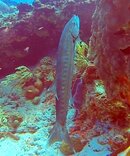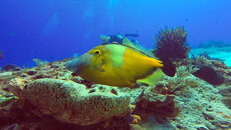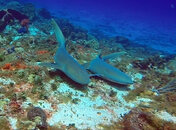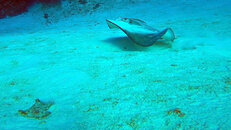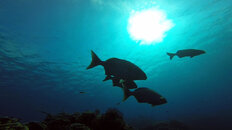You are using an out of date browser. It may not display this or other websites correctly.
You should upgrade or use an alternative browser.
You should upgrade or use an alternative browser.
Group Trip - Tres Pelicanos/Casa Mexicana
- Thread starter CajunDiva
- Start date
Please register or login
Welcome to ScubaBoard, the world's largest scuba diving community. Registration is not required to read the forums, but we encourage you to join. Joining has its benefits and enables you to participate in the discussions.
Benefits of registering include
- Ability to post and comment on topics and discussions.
- A Free photo gallery to share your dive photos with the world.
- You can make this box go away
CajunDiva
Contributor
And last...but CERTAINLY not least...the great turtle herder

CajunDiva
Contributor
Guess we'll see how the summer temperature in Cozumel compares to Louisiana...headed back down 7/17-7/24 
Cajuncru Diver
Contributor
Guess we'll see how the summer temperature in Cozumel compares to Louisiana...headed back down 7/17-7/24
Cozumel is probably 5 to 7 degrees cooler, man I can't wait to get down there so I can cool off !
CajunDiva
Contributor
The Cajuns have returned to Cozumel  We now have proof that the first trip was not a fluke. The gang at Tres Pelicanos are even better than before. Even though this trip turned into an anniversary celebration with just the two of us diving, we are being indulged just as well as we were with the group.
We now have proof that the first trip was not a fluke. The gang at Tres Pelicanos are even better than before. Even though this trip turned into an anniversary celebration with just the two of us diving, we are being indulged just as well as we were with the group.
I will start a new thread with trip report later.
 We now have proof that the first trip was not a fluke. The gang at Tres Pelicanos are even better than before. Even though this trip turned into an anniversary celebration with just the two of us diving, we are being indulged just as well as we were with the group.
We now have proof that the first trip was not a fluke. The gang at Tres Pelicanos are even better than before. Even though this trip turned into an anniversary celebration with just the two of us diving, we are being indulged just as well as we were with the group. I will start a new thread with trip report later.
Brodydog
Contributor
Well Happy Anniversary @CajunDiva! What better way to spend celebrating your anniversary.
CajunDiva
Contributor
Interesting point; not all parts of the reef are created equal. In the past it's been indicated by others that if you damage a section of hard coral (let's say your knee bumps into a brain coral, crushing some of the polyps against the hard frame), it will take a very long time for that to 'heal' - if it ever does. You've may have effectively permanently marred that coral.
But the turtle (which probably settles on hard corals from time to time) is eating a sponge, not a coral. Any idea how long it takes a barrel sponge to regenerate that kind of damage?
Most sponges I see diving are in pretty good condition; turtles are common enough that half-eaten (or worse) sponges ought to be very common if regeneration took a long time. But that's just my speculation.
It is tempting to go poke the turtle as if to say 'Yo, Dude, fins off the reef!'
Richard.
Richard -
I have been thinking a long time about what you said here. It's a very good point. Did your speculation ever lead to any research about sponge regeneration? I'm really interested in finding out more about their growth.
On our last trip, I saw a lionfish right in the middle of a barrel sponge and could have nailed it...but I couldn't bring myself to do it. I was too worried about what I might do to the sponge!
Maybe this speculation will bring me to my next level of education in scuba diving...
- Messages
- 53,681
- Reaction score
- 7,862
- # of dives
- 500 - 999
I'm curious as to what you carry that you would nail it with? I'd love to take some out, but with what? I already pack enough.On our last trip, I saw a lionfish right in the middle of a barrel sponge and could have nailed it...but I couldn't bring myself to do it. I was too worried about what I might do to the sponge!
horn34
Contributor
I'm curious as to what you carry that you would nail it with? I'd love to take some out, but with what? I already pack enough.
drrich2
Contributor
I've never read up on it; I imagine there are many variables (species of sponge, immediate environmental conditions, how big a 'bite' was taken,whether the sponge was knocked over, etc...).
Anyone have a sense of how quickly sponges repopulated reefs hit hard by hurricanes? IIRC, quite some years ago a Hurricane Wilma did serious reef damage in Cozumel; how many big sponges have come up since?
Richard.
Anyone have a sense of how quickly sponges repopulated reefs hit hard by hurricanes? IIRC, quite some years ago a Hurricane Wilma did serious reef damage in Cozumel; how many big sponges have come up since?
Richard.
Similar threads
- Replies
- 83
- Views
- 7,280
- Replies
- 30
- Views
- 4,495




